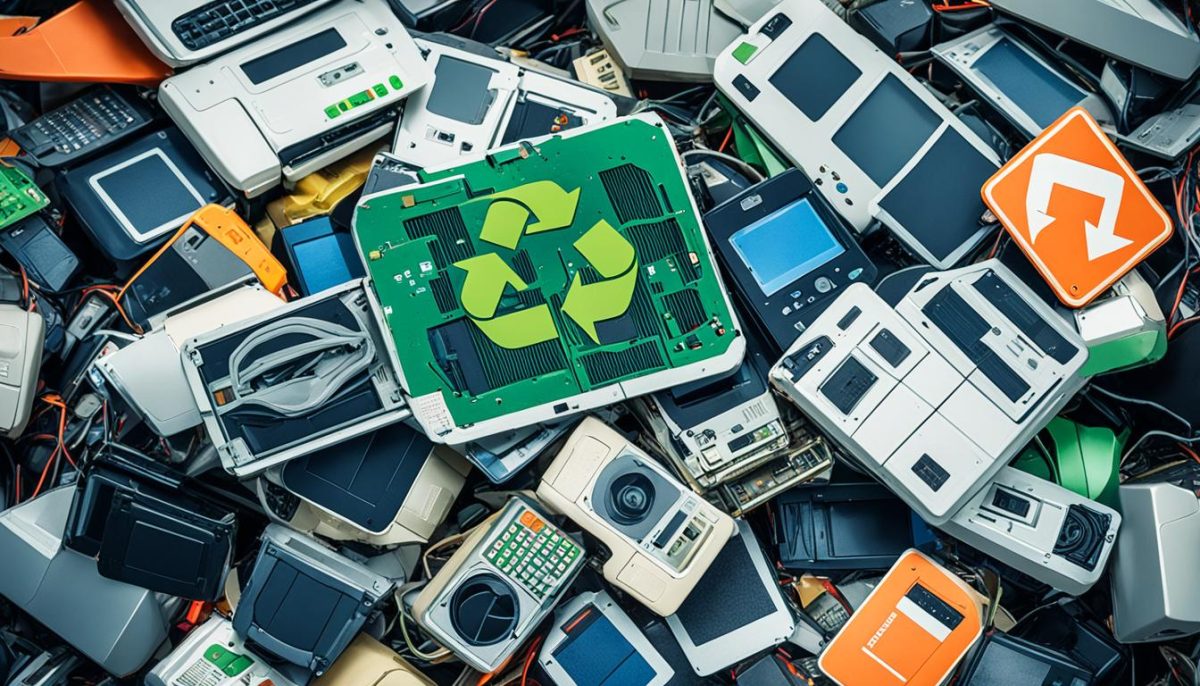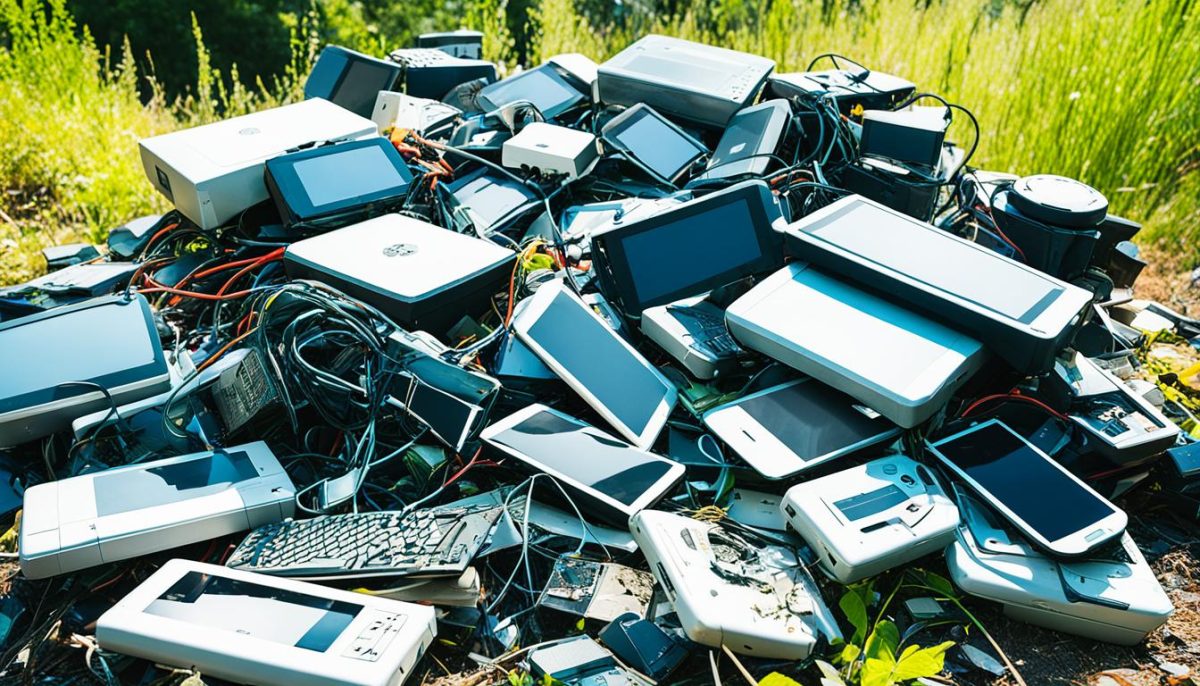
Welcome to the world of electronic waste, where our outdated gadgets and devices are piling up at an alarming rate. E-waste product stewardship is the solution we desperately need to address this growing crisis.
Electronic waste, or e-waste, refers to discarded electronic devices such as smartphones, laptops, and televisions. These products contain hazardous materials that can pollute the environment if not managed properly. Unfortunately, e-waste management strategies have been long overdue.
It’s time to recognize the urgency of this issue. The consequences of neglecting e-waste product stewardship are severe and far-reaching. The improper disposal or recycling of electronic waste releases harmful chemicals into the environment, contributing to air and water pollution. The extraction of raw materials for electronic devices also depletes valuable resources.
Effective e-waste product stewardship is essential to mitigate these environmental impacts. It involves responsibly managing the entire lifecycle of electronic products, from production to disposal. By implementing comprehensive management strategies, we can reduce pollution, conserve resources, and create a sustainable circular economy.
Various stakeholders play a crucial role in ensuring the success of e-waste product stewardship. Manufacturers need to prioritize durability, repairability, and recyclability in their product design. Consumers must be educated about responsible disposal options and encouraged to participate in recycling initiatives. Governments should establish regulations and support extended producer responsibility programs that hold manufacturers accountable for the proper management of electronic waste.
It’s time for action. Let’s explore the causes and consequences of e-waste in the next section and understand why e-waste product stewardship is so important for a greener and more sustainable future.
Understanding E-Waste: Causes and Consequences
Electronic waste, commonly referred to as e-waste, is a growing environmental concern that requires our immediate attention. This section aims to shed light on the causes and consequences of electronic waste, highlighting the need for proactive measures to address this critical issue.
Causes of Electronic Waste
The rapid pace of technological advancements plays a significant role in the generation of e-waste. As consumers, we are constantly enticed by newer, more advanced electronic devices, leading to the discarding of older ones. This cycle of consumption and disposal contributes to the accumulation of electronic waste.
Moreover, planned obsolescence, a deliberate strategy employed by manufacturers, exacerbates the e-waste problem. By designing products with limited lifespans, manufacturers encourage frequent upgrades and replacements, resulting in even more electronic waste.
Improper disposal practices also contribute to the increasing levels of e-waste. Many individuals and businesses dispose of electronic devices improperly, either landfilling them or exporting them to developing countries where disposal regulations are lax.
Consequences of Electronic Waste
The consequences of e-waste are far-reaching and encompass both environmental and health impacts. When electronic devices are improperly disposed of, they often end up in landfills where toxic chemicals and heavy metals leach into the soil and water, polluting the surrounding ecosystems.
The extraction and mining of natural resources to manufacture electronic devices contribute to resource depletion and habitat destruction. Additionally, the improper handling of e-waste exposes workers involved in recycling and disposal processes to hazardous substances, causing long-term health issues.
The table below highlights some of the key consequences of electronic waste:
| Consequences | Description |
|---|---|
| Pollution | E-waste releases hazardous substances into the environment, polluting air, soil, and water. |
| Resource Depletion | The extraction and processing of raw materials for electronic devices contribute to the depletion of natural resources. |
| Toxic Chemical Exposure | Improper handling of e-waste exposes workers to toxic substances, leading to serious health issues. |
| Waste of Valuable Materials | Electronic waste contains valuable materials like gold, silver, and copper that could be recovered and reused. |
It is evident that electronic waste poses significant environmental and health risks. Addressing the causes and consequences of e-waste requires collaborative efforts from individuals, businesses, and governments to adopt sustainable practices and implement effective e-waste management systems.
The Importance of E-Waste Product Stewardship
E-waste product stewardship plays a crucial role in ensuring a sustainable future. By effectively managing electronic waste, we can mitigate environmental pollution, conserve valuable resources, and foster the creation of a circular economy. Various stakeholders, including manufacturers, consumers, and governments, have a vital role to play in implementing and supporting robust stewardship programs.
The Benefits of E-Waste Product Stewardship
One of the primary benefits of e-waste product stewardship is the reduction of environmental pollution. Electronic devices contain hazardous materials such as lead, mercury, and cadmium, which can contaminate soil, water, and air if not properly handled. By implementing responsible disposal and recycling practices, we can prevent these toxic substances from harming the environment and human health.
Additionally, e-waste stewardship helps conserve valuable resources. Electronics contain precious metals like gold, silver, and copper, as well as rare earth elements. Through recycling and resource recovery processes, we can extract these materials from discarded devices, reducing the need for mining and minimizing resource depletion.
Moreover, e-waste product stewardship contributes to the development of a circular economy. Instead of following a linear model of production and disposal, a circular economy aims to minimize waste and keep resources in use for as long as possible. By extending the lifespan of electronic devices through repair, refurbishment, and recycling, we can create a more sustainable and resource-efficient system.
The Role of Stakeholders in E-Waste Product Stewardship
Effective e-waste product stewardship requires collaboration among various stakeholders. Manufacturers play a significant role by designing products with considerations for recyclability and easy disassembly. They can also take responsibility for the end-of-life management of their products through take-back programs or partnerships with certified recyclers.
Consumers also have a role to play in e-waste stewardship. By choosing durable products, responsibly disposing of old electronics, and participating in recycling programs, individuals can contribute to reducing e-waste and promoting sustainable consumption habits.
Governments play a crucial role in establishing regulations, policies, and incentives to encourage e-waste product stewardship. They can implement extended producer responsibility (EPR) programs, which hold manufacturers accountable for the proper management and recycling of their products. Governments can also invest in infrastructure for e-waste collection, recycling facilities, and public awareness campaigns.
Overall, the importance of e-waste product stewardship cannot be overstated. By taking collective action and prioritizing responsible management of electronic waste, we can protect the environment, conserve resources, and build a more sustainable future for generations to come.

Taking Action: Implementing E-Waste Product Stewardship
To address the growing concern of electronic waste (e-waste), it is crucial that we take action and implement effective e-waste product stewardship initiatives. Recycling plays a key role in mitigating the environmental impact of e-waste. By responsibly recycling electronic devices, we can prevent the release of hazardous substances into the environment and conserve valuable resources.
It is essential to provide consumers with accessible and responsible disposal options for their electronic devices. Through educational campaigns and convenient drop-off locations, we can encourage individuals to dispose of their e-waste properly. At the same time, manufacturers need to take responsibility for the end-of-life management of their products. Extended Producer Responsibility (EPR) programs can help ensure that manufacturers bear the responsibility of collecting and recycling electronic devices after their use.
Several countries and organizations have already taken significant steps towards implementing effective e-waste management systems. For example, Sweden has adopted a successful EPR program, resulting in high collection rates and efficient recycling. In the United States, companies like Dell and Apple have established take-back programs, allowing consumers to recycle their old electronics easily.
